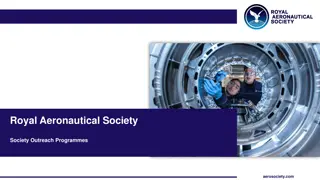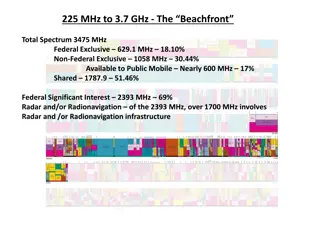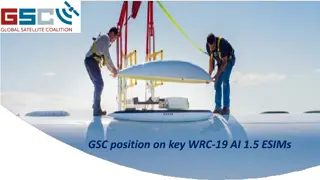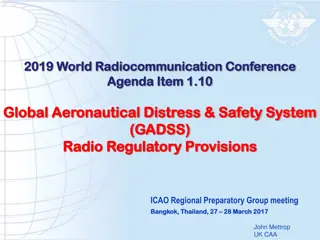Royal Aeronautical Society. Society Outreach Programmes.
Engage with innovative outreach programmes like Cool Aeronautics, Project Altitude, and Falcon 2 offered by the Royal Aeronautical Society to inspire primary and secondary school students in the field of aerospace. Discover opportunities for interactive learning, career exploration, and hands-on exp
0 views • 9 slides
High-Altitude Aeronautical Platform Station Market Trends 2023-2033
The global high-altitude aeronautical platform station (HAAPS) market is estimated to reach $3,338.1 million by 2033 from $1,194.4 million in 2023, growing at a CAGR of 10.82% during the forecast period 2023-2033.\nRead Report Overview: \/\/bisresearch.com\/industry-report\/high-altitude-aeronautica
5 views • 3 slides
Update to Aerodrome Reports and Forecasts: A Users Handbook to the Codes (WMO-No. 782) - SERCOM-3 Session
Presentation on the proposed 2025 update to the Aerodrome Reports and Forecasts handbook during the SERCOM-3 session in Bali. The update focuses on minor changes to aeronautical meteorological codes related to METAR and SPECI reports, aligning with ICAO Annex 3. The content includes background infor
0 views • 6 slides
Aeronautical Information Services and Cartography Inspectors Course Overview
This virtual course provides comprehensive training on aviation safety oversight, focusing on the roles and responsibilities of Aeronautical Information Services (AIS) and Cartography Inspectors. Participants will learn about regulatory frameworks, audit processes, competency assessment, and enforce
2 views • 87 slides
Enforcement Activities and Procedures Overview
The Civil Aviation Authority (CAA) is responsible for enforcing regulations to ensure compliance among stakeholders and service providers. Enforcement actions may include limitations, suspension, revocation, or financial penalties in cases of non-compliance. Official documents such as Advisory Circu
0 views • 27 slides
Romanian Civil Aeronautical Authority Operation Manuals Overview
The Romanian Civil Aeronautical Authority's operation manuals cover regulations and procedures for the transport of dangerous goods, including general policies, limitations, classification, marking, and labeling. The manuals also address the conditions under which weapons, war munitions, and sportin
0 views • 30 slides
Advancing Digital NOTAM Implementation: Evolution and Future Trends
The evolution of digital NOTAM implementation from its establishment in 1993 to the current focus on structured data sets for accurate and efficient updates in the aeronautical environment. The transition from text-based NOTAM to digital formats addresses the need for timely and reliable aeronautica
0 views • 9 slides
Short-Range Tests of Gravity: Theoretical Physics Project Overview
This project focuses on calculating modifications to the Newtonian gravitational force through experimental short-range tests of gravity. Utilizing the Standard-Model Extension (SME) test framework to search for potential violations of General Relativity and Newtonian Gravity. Key objectives include
1 views • 7 slides
Radio Frequency Spectrum Requirements for Civil Aviation Workshop Proceedings
This document discusses frequency assignment planning and interference models for VHF communication systems in civil aviation. It covers methodologies for establishing separation distances to prevent air-to-air interference and provides insights into interference models for co-frequency separation b
0 views • 13 slides
Military Spectrum Utilization in the 225-399.9 MHz Band
The 225-399.9 MHz band is crucial for military operations, utilized by NATO, allied nations, and the Coast Guard for tactical and strategic communications. It supports mobile-satellite systems, MUOS, air-to-ground communication, and more. The band also facilitates aeronautical communication, trunked
2 views • 21 slides
CITEL Working Instruments and Strategic Initiatives for Radiocommunications
Inter-American Telecommunication Commission (CITEL) plays a crucial role in coordinating strategic initiatives related to radiocommunications within the OAS. The Permanent Consultative Committee II (PCC.II) focuses on radiocommunications and works towards preparing for World Radiocommunication Confe
1 views • 10 slides
Enhancing Aviation Safety with Advanced Communication Networks in Africa
Aviation safety in Africa has been improved through the implementation of advanced communication networks like the SADC/1 and NAFISAT. These networks have replaced outdated infrastructure, allowing for reliable Air Traffic Services and data transmission. The initiative led by ATNS and IATA has signi
0 views • 15 slides
Establishment of ICAO Future VHF Sub-Group (FVSG) Summary
Advancements in satellite and communication technologies have paved the way for the establishment of the Future VHF Sub-Group (FVSG) under the Project Team Terrestrial (PT-T) of the Data Communications Infrastructure Working Group (DCIWG). The objective of FVSG is to develop provisions supporting gl
0 views • 6 slides
Aviation Seminar: The Evolution of CNS in European ATM Network
Exploring the past and future of Communication, Navigation, and Surveillance (CNS) in Air Traffic Management (ATM), this presentation delves into the critical role of CNS technologies, including airspace management, air traffic flow, and aeronautical information services. It highlights developments
0 views • 13 slides
ESIM Operations in GSO FSS Networks: WRC-19 AI 1.5
Addressing the growing demand for broadband satellite communications with mobility, WRC-19 AI 1.5 focuses on ESIM operations beyond specified frequency bands. It aims to facilitate ESIM operations in aeronautical, maritime, and land settings within GSO FSS networks, subject to technical and regulato
0 views • 9 slides
Updates on Iridium's Participation in WRC-23 Preparations
Iridium is actively involved in the WRC-23 preparations, focusing on agenda items such as modernizing GMDSS, new MSS allocations, aeronautical satellite VHF, and unmanned aircraft support. They seek to protect spectrum, expand services, and support connectivity advancements in various sectors throug
0 views • 11 slides
Update on AEEC IPS for Aeronautical Safety Services
This information paper provides an update on the progress and plans within AEEC to advance the IPS for Aeronautical Safety Services standards. It outlines the submission of the ARINC Project Initiation/Modification (APIM) to define and specify IPS, steps involved in the development plan, and upcomin
0 views • 19 slides
Sub Working Group Conclusions on Various Spectrum Interference Analyses
The draft report highlights conclusions from different sub working groups regarding spectrum interference analyses in various sectors like aeronautical telemetry, small unmanned aerial systems, air combat training systems, and precision guided munitions. It discusses feasibility challenges, separati
0 views • 7 slides
Insights into Global Aeronautical Distress & Safety System (GADSS)
The 2019 World Radiocommunication Conference addressed the GADSS, focusing on radiocommunication requirements, regulatory provisions, and the need for additional spectrum. GADSS aims to enhance global flight tracking post AF 447 & MH 360 incidents. Agenda Item 1.10 at WRC-19 emphasized the importanc
0 views • 16 slides


















